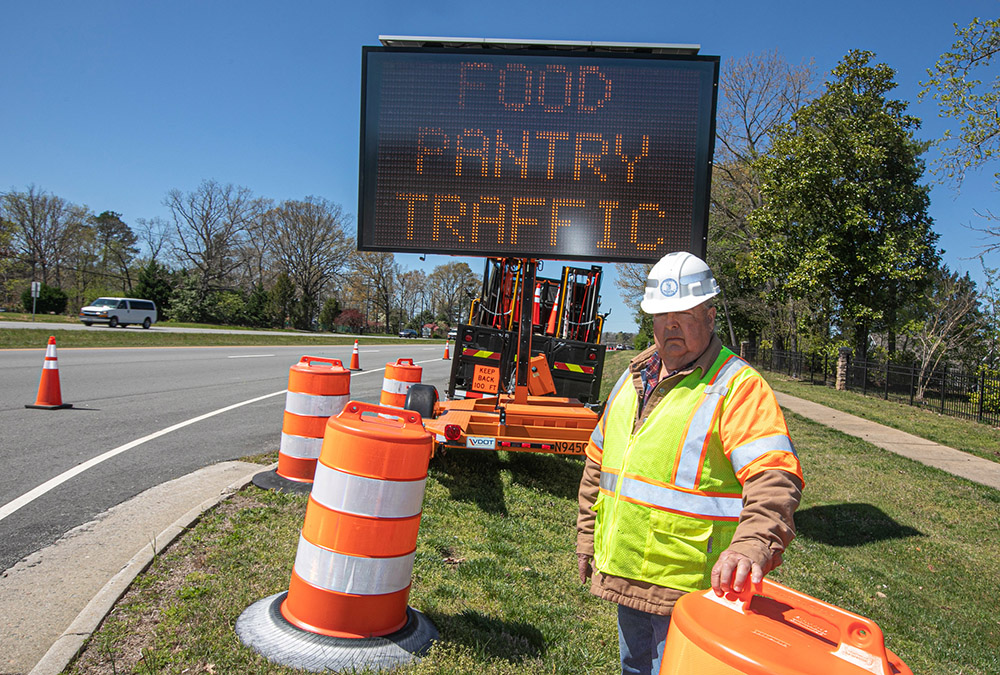Food Insecurity and Food Pantry Use
Report offers second week of estimates for 10 U.S. states and 8 metro areas
Get all our news
Notably more than 1 in 10 respondents in the states of New York and Texas reported receiving help from a food pantry in the previous seven days.”
Diane Schanzenbach and Abigail Pitts
Results from the COVID Impact Survey, Week 2 (May 4–10, 2020)

A man assists with traffic control at the Chesterfield Food bank.
The COVID Impact Survey also collected representative information for a select set of states and metropolitan areas. The table below (Table 7 in the full report) presents estimates of rates of food insecurity and food pantry use in 10 states and 8 metropolitan areas, with 95% confidence intervals in the even columns. IPR Director and economist Diane Whitmore Schanzenbach and research analyst Abigail Pitts combined information from the April and May surveys, as there were very few statistically significant changes across months. Refer to the summary page for highlights from their report.
The exceptions include that between April and May food insecurity in Florida declined, and food pantry use statistically increased in California and Florida and declined in Colorado. Notably more than 1 in 10 respondents in New York and Texas reported receiving help from a food pantry in the previous seven days.
Table 7. Food Insecurity and Food Pantry Use: Selected U.S. States and Metro Areas |
||||
| Food Insecure |
Received Help from a Food Pantry |
|||
| Share of Respondents | 95% Confidence Interval |
Share of Respondents | 95% Confidence Interval | |
| (1) | (2) | (3) | (4) | |
| Select U.S. States | ||||
| California | 25% | [22.9%, 27.6%] | 7% | [6.0%, 8.9%] |
| Colorado | 17% | [14.0%, 19.1%] | 4% | [2.9%, 5.7%] |
| Florida | 22% | [19.2%, 24.4%] | 5% | [3.2%, 5.9%] |
| Louisiana | 35% | [31.5%, 38.8%] | 7% | [4.7%, 8.5%] |
| Minnesota | 11% | [8.9%, 13.3%] | 5% | [3.4%, 6.4%] |
| Missouri | 22% | [18.6%, 24.6%] | 7% | [5.1%, 8.7%] |
| Montana* | 14% | [11.0%, 17.8%] | 5% | [2.6%, 6.7%] |
| New York | 26% | [22.8%, 28.6%] | 11% | [8.9%, 13.1%] |
| Oregon | 22% | [18.9%, 24.5%] | 8% | [6.1%, 9.8%] |
| Texas | 26% | [23.3%, 29.5%] | 10% | [7.4%, 11.6%] |
| Select U.S. Metropolitan Areas |
||||
| Atlanta-Sandy Springs-Alpharetta, Georgia | 19% | [16.3%, 21.8%] | 6% | [4.2%, 7.6%] |
| Baltimore-Columbia-Towson, Maryland | 19% | [16.5%, 22.3%] | 5% | [3.2%, 6.3%] |
| Birmingham-Hoover, Alabama | 26% | [22.4%, 29.1%] | 4% | [2.5%, 5.5%] |
| Chicago-Naperville-Elgin, Illinois-Indiana-Wisconsin | 23% | [20.3%, 26.0%] | 5% | [3.6%, 6.6%] |
| Cleveland-Elyria, Ohio | 21% | [17.9%, 23.5%] | 7% | [5.1%, 8.6%] |
| Columbus, Ohio | 22% | [19.2%, 25.1%] | 7% | [5.2%, 9.0%] |
| Phoenix-Mesa-Chandler, Arizona | 25% | [21.2%, 28.2%] | 10% | [7.3%, 12.1%] |
| Pittsburgh, Pennsylvania | 14% | [11.6%, 16.5%] | 5% | [3.8%, 7.1%] |
Diane Whitmore Schanzenbach is the Margaret Walker Alexander Professor and IPR Director. Abigail Pitts is a research analyst. Read the full report, "Estimates of Food Insecurity During the COVID-19 Crisis: Results from the COVID Impact Survey, Week 2 (May 4–10, 2020)."
Photo credit: Flickr (Photo by Tom Saunders, VDOT)
Published: May 18, 2020.


